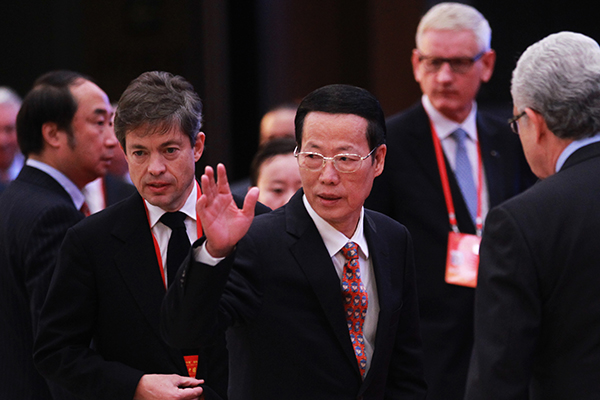GDP growth targeted at 6.5 to 7% through 2020
Updated: 2015-11-02 07:14
By Chen Jia(chinadaily.com.cn)
|
|||||||||||
 |
|
Vice-Premier Zhang Gaoli attends the opening ceremony of the 2nd Understanding China Conference in Beijing on Nov 1, 2015. [Photo/China Daily] |
Vice-premier says this would help nation avoid middle-income trap
China is aiming to maintain an average annual GDP growth rate of 6.5 to 7 percent until 2020, without aggressive stimulus or blind expansion of investment, said Vice-Premier Zhang Gaoli on Sunday."If China can successfully achieve the 13th Five-Year Plan (2016-20), we will avoid the middle-income trap, which will be a miracle in the world's development history," said Zhang, in his speech during the opening ceremony of the 2nd Understanding China Conference.
The conference, in Beijing, was jointly hosted by the government think tank China Institute for Innovation and Development Strategy, Chinese People's Institute of Foreign Affairs and the US-based 21st Century Council.
"We predicted that from 2011 to 2015, the average annual growth rate would achieve 7.8 percent," said Zhang.
He said that innovation was the key to driving development, and major problems should be solved during the economic restructuring reforms.
The fast but unsustainable development model should be abandoned, he said.
Economists predicted recently that it was unlikely to see a fast rebound in the fourth quarter, and a 6.9 percent GDP growth is possible.
This would mean no change from the third quarter's 6.9 percent growth, the first dip below 7 percent since the global financial crisis.
The trend has also been suggested by the latest data.
The National Bureau of Statistics reported on Sunday that manufacturing contracted in October for the third straight month and the service sector saw slower growth.
The manufacturing purchasing managers index was 49.8 in October, below the 50 level that separates expansion from contraction, and the same as in September.
Meanwhile, the figure for nonmanufacturing sectors, including service and construction businesses, fell to 53.1, compared with 53.4 in September.
Zhao Qinghe, an economist at the NBS, said that further cooling of the manufacturing sector is possible due to the fragile global recovery.
"Export and import in this sector may remain weak," he said. There remains a long-term slowing trend of the traditional manufacturing industry with overcapacity problems.
Related Stories
A below 6% growth target best: economist 2015-10-30 15:48
China's regional growth indicates economy bottoming out 2015-10-29 16:03
China enters key phase to avoid middle income trap 2015-10-29 09:15
Potential for China's economy lies in improved efficiency 2015-10-27 16:57
Understanding China's 'around 7%' growth target 2015-10-26 14:16
Today's Top News
China and France sign 17 cooperative agreements
Technical fault, pilot error ruled out in Egypt jet crash
Russian jet broke up in mid air
GDP growth targeted at 6.5 to 7% through 2020
Two-child policy to add $12b in consumption
China to buy Airbus jets in $17b deal
China to allow two children for all couples
China's central bank dismisses QE rumor
Hot Topics
Lunar probe , China growth forecasts, Emission rules get tougher, China seen through 'colored lens', International board,
Editor's Picks

|

|

|

|

|

|






